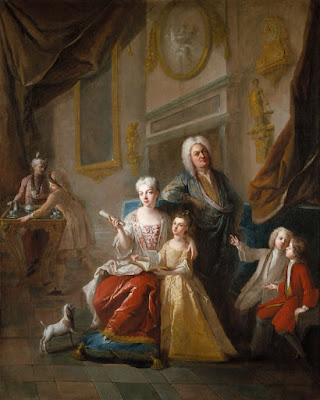 Across the pond again, this time to Paris. More luncheons, dinners and lectures and one great fair, the “Salon du dessin”. This is drawings week in Paris and a great deal is going on.
Across the pond again, this time to Paris. More luncheons, dinners and lectures and one great fair, the “Salon du dessin”. This is drawings week in Paris and a great deal is going on.Many of the graphics dealers in Paris who do not exhibit at the Salon hold their own exhibitions showing their tempting wares. The auction houses schedule drawings sales to occur this week in order to take advantage of all the collectors who have come to town. A true highlight takes place the night before the opening of the Salon in the drawings study room of the Louvre, only for invited guests. Drawings are put out without frames and no labels for the cognoscenti to study. There is always a theme and this year it was collectors’ marks. When used they are put directly on the drawing and can be most helpful in tracing a drawing’s history. The Fondation Custodia in collaboration with the Graphics department of the Louvre have updated the famous catalog of marks by Frits Lugt on a new website, launched this week. Here you can research any marks that you may find in your collection. During the Salon there is a colloquium on the same theme and this year it was about how to use the new website and how a web based inventory can be supplemented and added to over time. Then there were more talks on the advantages and pitfalls of relying on what the marks tell us.
 But, of course, the highlight of the week and around which all the rest revolves is the Salon du Dessin. It takes place at the Palais de la Bourse, which is the old stock exchange, a majestic and imposing place to hold an exhibition. It is certainly a more auspicious venue that the fair grounds in Maastricht and this fair does it proud.
But, of course, the highlight of the week and around which all the rest revolves is the Salon du Dessin. It takes place at the Palais de la Bourse, which is the old stock exchange, a majestic and imposing place to hold an exhibition. It is certainly a more auspicious venue that the fair grounds in Maastricht and this fair does it proud.Assembled here are about 40 of the best dealers in the world showing only stellar works of art. There are just watercolors and drawings, no prints of any kind.
What made the 2010 fair particularly exciting was what seemed like an opening night feeding frenzy. The fair opening runs from 4pm until 10:30pm and I walked in during the 3rd hour. The crowd was incredible in spite of a transit strike in Paris and there were red dots everywhere. In one booth I walked into I spotted 3 works that I coveted but I was too late. Another excited dealer said to me, it is incredible. We have made 4 sales already I have two pieces that I think will go in the next day or two and glancing behind my back he added and I think my colleague is about to sell another one. This kind of action has not been seen at an art fair in a number of years.
 The next day I spoke to a dealer who had done Maastricht and the Salon which starts two days after in another country and he said that Maastricht was ok but this was much better sales wise.
The next day I spoke to a dealer who had done Maastricht and the Salon which starts two days after in another country and he said that Maastricht was ok but this was much better sales wise.There is no way I could pick my favorite piece in the fair. There is high quality in all areas of European drawings and watercolors from the 16th through the 20th century.
One of my favorite booths is one of anonymous drawings. Each exhibitor is invited to submit a drawing that they have not been able to identify. The prices range from a low of 600 euros for a portrait of somebody’s aunt without a date or country of origin even suggested to a lovely sheet of a mother and child which is surely Venetian 16th century at 14,000 euros. But why would anyone buy an anonymous drawing?... well, that is for another blog.







